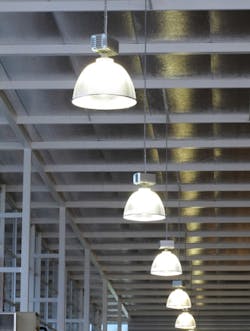In Part 1, we looked at how to size a branch circuit and walked through a simple example. So if you’re sizing a feeder, why don’t you do it the same way? Except in cases where a feeder is also essentially a branch circuit by dint of supplying a single load (e.g., a large motor supplied by a feeder), you’ve already done the branch circuit load calculations.
In normal power distribution, the purpose of a feeder is to supply power to multiple branch circuits. The typical arrangement in an industrial facility is a 480V feeder supplies a transformer that supplies a panel (or multiple transformers, each supplying a panel). That transformer might supply the panel with 120V for office loads, 277V for lighting loads, or maybe 480V for production equipment. Each overcurrent protective device (OCPD) in that panel is supplied by the transformer that’s supplied by that feeder.
You can follow the flow of power from the service through the feeder through the branch circuit, but the flow of demand is in the opposite direction. The individual loads add up on the branch circuit, and the branch circuits add up on the feeder. This means that as part of the process of determining the load on the feeder, you add up the branch circuit loads that feeder supplies. Because you can’t know your feeder load until you’ve calculated your branch circuit loads, you do branch circuit calculations first.
Load analysis
You need to do a bit of load analysis before sizing your feeder OCPD and conductors. You don’t need to look at whether loads are continuous or noncontinuous, as you’ve already accounted for this in determining your total VA for each branch circuit.
Typically, but not always, you can simply add up the VA of the branch circuits to determine the VA on the feeder. For example, a feeder supplies 10 branch circuits for lighting at 452VA each. That totals up to 4,520VA. But what if those are HID lights, commonly used in high-bay applications (Photo)?
HID lights are an excellent choice for many reasons, but the downside is their ballasts make them nonlinear loads. This has some ramifications.
First, you’ll probably want to derate the conductors. This is especially true if you have long runs, and voltage drop comes into play. The good news is that manufacturers of highly nonlinear loads like HID lighting typically provide derating factors. And because high-bay lighting is a ceiling application, you also must account for the higher ambient temperature using the correction factors in Tables 310.15(B)(2)(a) and (b).
Second, this type of load means you have to treat the neutral as a current-carrying conductor [310.15(B)(5)(c)].
Third, not all loads run at a given time. Lighting, which we’ve been talking about, isn’t a diverse load — that is, if you turn the lights on, they all operate. That is not true of all loads, however.
Some loads operate in a mutually exclusive fashion. That’s why, for example, you use the larger of the heating or air-conditioning load when determining the total load. That’s part of accounting for load diversity. Load diversity is really an engineering decision, and you base it on the expected operation of the equipment. Consider an industrial shop that has one portable arc welder and 10 welding outlets. Only one outlet will be in use at any given time. Suppose this is a 250A 220V/380V arc welder. If you didn’t factor in load diversity, you’d need to add a service instead of just a single breaker.
You do this analysis to determine the actual maximum VA that will be on the feeder. Once this is done, you can turn your attention to sizing the OCPDs and then the conductors.
To illustrate the basics of feeder sizing, we’ll expand on the example we used in Part 1. Now we’re sizing the feeder for six of those branch circuits. We’ll start with the OCPD.
OCPD sizing
In this example, we can simply add up the branch circuit loads to determine the feeder load and size the OCPD. Calculate the feeder load per Art. 220, Parts III, IV, and V.
For our example, we multiply our 452VA load by 10 branch circuits to arrive at 4,520VA. Because lighting is a single-phase load, we divide by the voltage to determine the current.
In Part 1, these were 480V lights, but the corporate office has just sent out a memo stating that all lights must be 277V because the company has contracted for special discount pricing for 277V lamps. Previously with 480V lights, each branch circuit drew 5.65A. Now with 277V lights, it’s going to draw 9.8A.
If you divide your total of 4,520VA by 277, you see the feeder carries 16.31A. Using the next-size-up rule, the OCPD is 20A. But suppose it’s a warehouse supplied by just that one feeder, and it has four additional loads:
• Electric heaters totaling 250,000VA
• Office air-conditioner: 15,000VA
• Convenience receptacles: 10,000VA
• Temperature-controlled exhaust fans: 50,000VA
You don’t heat and cool at the same time, so applying load diversity gives us an additional load equal to the heater load plus the convenience receptacles. Odds are that the air conditioner and receptacles are powered by the same 120/240 transformer. Who’s to say that someone won’t add more circuits in the future?
It’s a good engineering decision to allow for the maximum transformer VA minus the air-conditioner VA and add that number to the 250,000VA. This way, the feeder will have to be pulled only once rather than needing to be replaced due to a simple upgrade or small expansion project.
Conductor sizing
For the current-carrying conductors, use the same approach we outlined in Part 1. Whether sizing conductors for feeders or branch circuits, you work with the ampacity tables the same way. Select a feeder conductor with sufficient ampacity to carry your calculated load [215.2].
The complicating issue here is the neutral, which is normally the grounded conductor. Any time the majority of the load on a feeder is nonlinear, you must treat your neutral as a current-carrying conductor.
In any other situation, size the feeder neutral at least as large as the grounding electrode conductor (GEC) [250.122], but also review 220.61 — because you may need to go larger than the size of the GEC.
Sizing per 220.61 involves some load analysis and calculations. The only downside to an oversized neutral is a slightly higher cost of materials. If a significant part of, though not a majority of, the load is nonlinear, it often makes sense for a small project to just treat it as a current-carrying conductor. Sometimes, it makes no difference, and we’ll see that play out in our example.
Typical lighting circuit feeder
Let’s apply what we’ve learned to sizing the OCPD and conductors for a 277V feeder supplying 10 branch circuits, each consisting of six 400W lights.
Here’s the 6-step process:
Step 1: Calculate total load. The easiest way to do this is to add up your branch circuit VA. Remember that you characterized these as continuous and noncontinuous already, thereby satisfying the last sentence of 215.2(A)(1).
Step 2: Calculate amps. In our example, 4,520VA ÷ 277V = 16.4A. Don’t forget to divide by the square root of three for 3-phase loads. If your feeder has a mix of single-phase and 3-phase loads, you have a mix of calculations to perform.
Step 3: Size the OCPD. Use the next size up [240.6]. For our example, that’s 20A.
Step 4. Identify the table. You’re running 3 THHN conductors in EMT. Use Table 310.15(B)(16).
Step 5. Apply temperature correction factor. For the branch circuits, we had to consider the ceiling temperature. But the feeder runs to a transformer sitting on a poured pedestal on the floor. The warehouse will be maintained at a maximum 80°F. From Table 310.15(B)(2)(b), we see this requires us to multiply the allowable ampacity by 1.22. Alternatively, we can multiply our amps by 0.82, and that gives us 13.5A.
Step 6. Size the conductor per the required ampacity. Using the 60°C column, we find this circuit requires a conductor at least 14 AWG.
It’s interesting that for the feeder and branch circuits, you’re going to run 14 AWG for the whole installation, including the neutral. This is something to keep in mind before delving into complex complications for sizing the neutral.
Things get a bit turned on their head when motors are involved. In Part 3, we’ll look at why that is and what to do about it.
Lamendola is an electrical consultant based in Merriam, Kan. He can be reached at [email protected].





